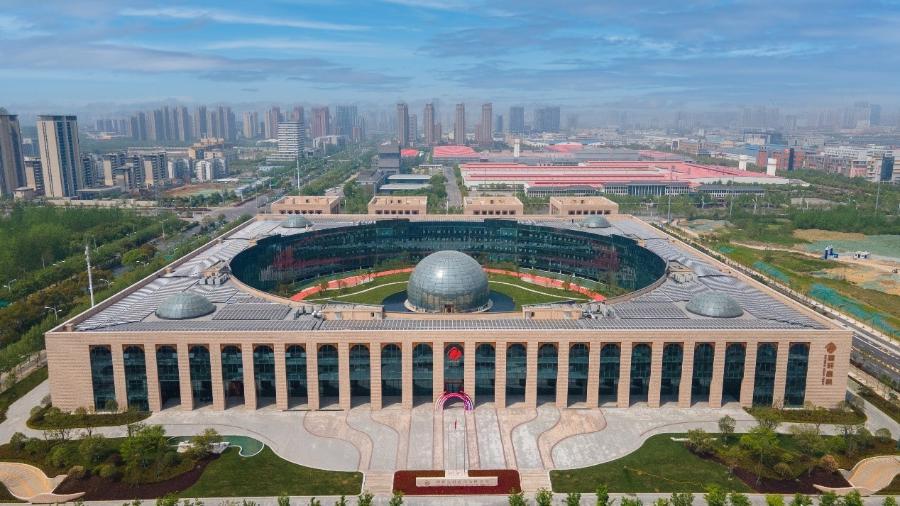Chasing the wind and chasing the sun, China's new energy development has attracted worldwide attention
Abstract
Chasing the wind and chasing the sun, China's new energy development has attracted worldwide attention
Recently, the first unit of the "solar thermal energy storage+photovoltaic+wind power" demonstration project in Yumen, Gansu was successfully lifted. After the project is completed, the annual power generation can reach 1.75 billion kilowatt hours; On July 19th, with three 123 meter long blades slowly rotating, China's 16 MW ultra large capacity offshore wind turbine successfully connected to the grid for power generation
Since 2023, a large number of major new energy projects such as wind and photovoltaic have been vigorously promoted, and China's new energy industry has taken solid steps forward. In the first half of the year, the newly installed capacity of wind and photovoltaic power in China exceeded 100 million kilowatts, with a cumulative installed capacity of about 860 million kilowatts and a wind and photovoltaic power generation of 730 billion kilowatt hours.
Ranked first in the world in terms of installed capacity and power generation
In Hami, Xinjiang, a typhoon generator rotates against the wind, creating a spectacular scene and picturesque scenery. The vast desert of the past has transformed into a wind power base, continuously delivering green electricity to the outside world.
At present, Xinjiang has built a new energy base with a capacity of tens of millions of kilowatts in Hami, and has built new energy clusters with a capacity of millions of kilowatts in cities such as Hami, Changji Hui Autonomous Prefecture, Urumqi, Turpan, Altay, and Tacheng. Data shows that in the first quarter of 2023, the wind power generation of Xinjiang power grid was 1.267 million kilowatt hours, an increase of 9% year-on-year; The utilization rate of wind power is 98.8%, an increase of 4 percentage points year-on-year.
Chasing the wind and chasing the sun, the scenery is endless.
In summer, at the National Wind and Solar Energy Storage and Transmission Demonstration Project located in Zhangbei County, Zhangjiakou City, Hebei Province, a large wind turbine slowly rotates in the distance, and the photovoltaic panels shine brightly in the sunlight. This demonstration project integrates wind power generation, photovoltaic power generation, energy storage system, and intelligent transmission, relying on more than 30 new technologies and 119 sets of high-tech equipment to solve the global problem of large-scale centralized grid connection and integrated application of new energy.
Currently, China is focusing on desert, Gobi, and desert areas, accelerating the construction of new energy bases on seven continents, including the upper reaches of the Yellow River, the Hexi Corridor, the Yellow River's "bend", northern Hebei, and Xinjiang; Coordinate the development and construction of the two major water and scenery comprehensive bases in Sichuan, Yunnan, Guizhou, Guangxi, and southeastern Tibet; Optimize the layout of offshore wind power, carry out far-reaching offshore wind power planning, and promote large-scale development and demonstration development of offshore areas.
"Since 2023, we have fully utilized the advantages of short construction cycles and fast results in new energy construction, and increased our efforts in new energy construction." Guan Peng, head of the Economic Operation and Adjustment Bureau of the National Development and Reform Commission, said that in the first half of the year, wind and solar power generation increased by 16% and 7.4% respectively, forming an important supplement to power generation capacity.
Liu Mingyang, the head of the Electric Power Department of the National Energy Administration, introduced that since the 18th National Congress of the Communist Party of China, China has achieved remarkable achievements in the development of new energy, with installed capacity and power generation ranking first in the world. The installed scale of wind and photovoltaic power generation is constantly expanding, and has become the dual main body of new power generation and new power generation in China. According to statistics, from January to June 2023, the proportion of newly installed wind and photovoltaic power in the country reached 71%, and the newly generated electricity accounted for more than 54% of the country's newly generated electricity, effectively meeting the demand for new electricity in the country.
At the same time, China's efforts to innovate new energy technologies are constantly increasing, highlighting its international competitive advantages, improving its technological equipment level, and continuously reducing development and construction costs, providing strong support for China's basic entry into a new stage of affordable and non subsidized development of new energy. Currently, key components such as photovoltaic modules, wind turbines, and gearboxes produced in China account for 70% of the global market share.
New models and formats are emerging in competition
On the desert grassland of Sunite Right Banner in Xilingol League, Inner Mongolia Autonomous Region, under rows of deep blue photovoltaic panels, sheep are leisurely eating grass. It is understood that the total installed capacity of this photovoltaic power station is 200000 kilowatts, equipped with an 85 megawatt hour energy storage system, and will be connected to the grid for power generation in December 2022.
"The photovoltaic panels are placed in the air, and there is still a lot of room for utilization in the grassland under the panels. We have set the distance between the lowest point of the photovoltaic bracket and the ground to 1.5 meters, which is higher than the ordinary photovoltaic bracket, leaving enough space for the sheep to move around, achieving power generation on the panel and grazing under the panel," said Guan Chao, the director of the photovoltaic power station.
In the demonstration project of green power stations in Ulanqab City, Inner Mongolia, some cold and drought resistant plants such as sheep grass are planted under the photovoltaic panels, and a green development model of "on board power generation and under board planting" is being formed. It is reported that photovoltaic panels can reduce surface water evaporation and improve vegetation growth rate.
Currently, Inner Mongolia is continuously increasing its efforts in the development of new energy such as wind and solar power, and achieving rapid development of "photovoltaic+" comprehensive utilization projects. In addition, Shanxi, Qinghai, Hubei, Zhejiang and other regions are actively developing "photovoltaic+" projects to promote the three-dimensional spatial value-added utilization of photovoltaic power stations.
Looking across the country, new models and formats such as "photovoltaics+agriculture", "photovoltaics+transportation", "photovoltaics+buildings", "photovoltaics+ecological governance", and "integration of water and solar energy" are emerging in competition. The application scenarios are continuously innovating, and a new situation of complementary, localized, and diversified integrated development is accelerating.
The 14th Five Year Plan for the Development of Renewable Energy issued by the National Development and Reform Commission and other departments proposes to vigorously promote the integrated development of photovoltaic power generation in multiple scenarios. Actively promote the "photovoltaic+" comprehensive utilization action, and encourage composite development models such as complementary agriculture (animal husbandry) and fishery light.
The relevant person in charge of the National Development and Reform Commission stated that it is imperative to vigorously develop wind and photovoltaic power in the context of carbon peak and carbon neutrality. China's deserts, Gobi, and deserts have vast areas and abundant scenic resources. Through the integrated circular development model of "power generation on the board, planting under the board, sand control and soil improvement, and comprehensive utilization of water resources", wind and photovoltaic sand control, wind prevention, and grass fixation are carried out, which helps to improve the local ecological and living environment, achieve the integration and friendly development of new energy and ecology.
High quality development with broad prospects
Recently, the National Development and Reform Commission approved the ± 800 kV ultra-high voltage direct current transmission project from Hami to Chongqing. This project is one of the 102 major projects determined in the national "14th Five Year Plan" development plan, and also the third DC channel for "Xinjiang Power Transmission". It is understood that after the completion of the project, it can transmit more than 40 billion kilowatt hours of electricity to Chongqing every year, of which new energy electricity accounts for more than 50%.
"In terms of transmission channel planning and construction, since 2023, projects such as the Baihetan Zhejiang DC project and the Shaanbei Hubei DC supporting power supply have been put into operation one after another." Liu Mingyang said that as of the end of June, China's "West East Power Transmission" transmission capacity has exceeded 300 million kilowatts, with the maximum transmission capacity of the cross provincial and cross regional DC channel during the summer period reaching 180 million kilowatts, an increase of about 17.5 million kilowatts from the same period in 2022.
In addition, Liu Mingyang introduced that in recent years, driven by the large-scale development and consumption demand of wind and photovoltaic power generation, and supported by relevant industrial policies, China's new energy storage has developed rapidly, and the installed capacity has grown rapidly. As of the end of May 2023, the installed capacity of new energy storage in China has exceeded 12 million kilowatts. At present, more than 10 provinces are carrying out pilot demonstrations of new energy storage, driving the rapid development of various technological routes such as lithium-ion batteries, flow batteries, and compressed air energy storage. The relevant industrial chain system is also constantly improving.
The 14th Five Year Plan period is the first five years for China to embark on a new journey of comprehensively building a socialist modernized country and advance towards the second centenary goal. It is also a crucial period for China to accelerate the green and low-carbon transformation of energy and implement the national independent contribution goal of addressing climate change.
China has committed to peaking carbon dioxide emissions before 2030 and striving to achieve carbon neutrality before 2060. It is clear that the total installed capacity of wind and solar power will exceed 1.2 billion kilowatts by 2030. Standing at a new historical starting point, the development of new energy is facing new situations and tasks.
Experts believe that currently, new energy shoulders significant historical responsibilities and glorious missions, with broad prospects. At the same time, we must also be aware that the high-quality development of new energy also faces new challenges. The time for China to achieve carbon peak and carbon neutrality is tight, and the task is heavy. It is a long-term, complex and arduous systematic project, involving a wide range of areas, a wide range of impacts, and multiple factors to consider. The development of new energy must comprehensively consider multiple constraints and objectives. At the same time, the large-scale development of new energy still faces many bottlenecks, difficulties, and pain points, such as increasingly prominent land use constraints, insufficient adaptability of traditional power systems to the integration and consumption of new energy into the grid, and the need for deepening the reform of "streamlining administration and delegating power".
Experts suggest that the development of new energy must maximize the potential of various available spaces. Utilize unused land such as sandy land, bare land, and bare rocky gravel land as much as possible without competing with other production activities, especially accelerate the planning and construction of large-scale wind and solar power bases with a focus on deserts, Gobi, and desert areas. At the same time, we must adhere to the principle of combining land and sea, not only seeking space on land but also expanding space at sea, supporting the development of offshore wind power, encouraging the development of offshore photovoltaics, and creating a new integrated development model of "wind, solar, and fishing".
In addition, facing the urgent and long-term needs of new energy, we will focus on key, forward-looking, and disruptive technologies, increase financial investment, concentrate on tackling a batch of key core technologies, and reserve a batch of basic cutting-edge technologies, striving to achieve independent and controllable industrial and supply chains, and provide strong industrial support for the high-quality development of new energy.



 18013199206
18013199206







